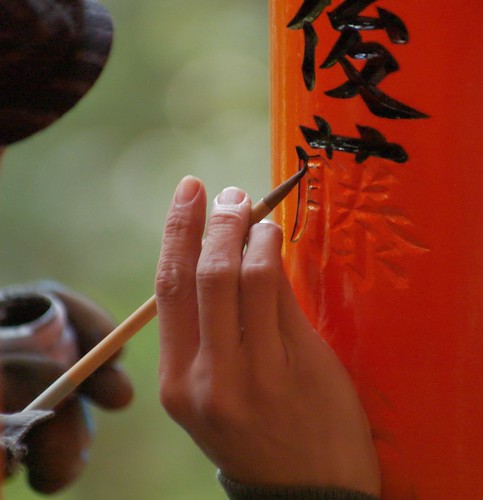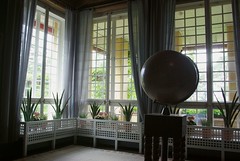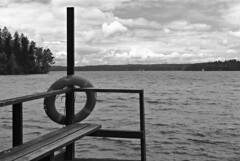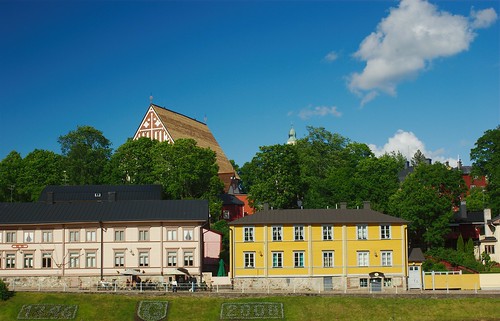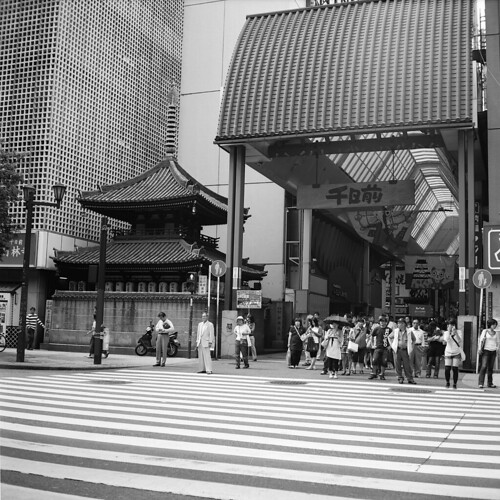I just saw today that the experimental post-Windows pipe-dream operating system in development at Microsoft Research is codenamed "midori", Japanese for "green" or "greenery". And the very same day, the Mozilla foundation announces an unstable alpha version of the next Firefox, codenamed "Shiretoko", the northernmost peninsula on Hokkaido in Japan.
And since two examples is more than enough statistical material to constitute a trend in the blog world (many real newspapers don't require even one), I hereby declare this to be the Year of Japanese Language Software Codenames. Remember, you heard it here first!
Thursday, July 31, 2008
Tuesday, July 29, 2008
How Not To Handle Job Interviews
A person applies for a job as a network engineer. As part of the hiring process he is given a technical questionnaire to fill in at home. He is expected to know the answers (most questions are quite easy), or to use Google or similar resources to find out for himself. Instead of doing so, though, the applicant posts the entire questionnaire on a technical online forum and asks its participants to please fill it in for him.
Hilarity ensues when it turns out the interviewer finds the forum post and tells the applicant not to bother turning in the form any more.
Hilarity ensues when it turns out the interviewer finds the forum post and tells the applicant not to bother turning in the form any more.
Monday, July 28, 2008
Are you Gay? You Can't Fly Here.
Monday morning and a friend passes on a newspaper notice that is just too good not to share:


Wednesday, July 23, 2008
Interesting Times
Interesting times at my current job. Things will get better again in due course. Meanwhile, a few things I've wanted to write about but never found the energy:
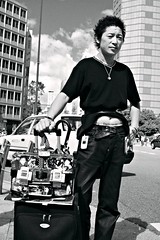 A straightforward way to cut welfare costs and improve your ministry's economics: Refuse to accept welfare applications. Applicants would be refused application forms, or officials would refuse to accept and process the forms when presented. Three confirmed dead from this policy so far; but of course the welfare statistics look good. When it comes down to the wire - support your ministry or help the downtrodden people you're supposedly hired to assist - it's good to know which side these officials will come down on.
A straightforward way to cut welfare costs and improve your ministry's economics: Refuse to accept welfare applications. Applicants would be refused application forms, or officials would refuse to accept and process the forms when presented. Three confirmed dead from this policy so far; but of course the welfare statistics look good. When it comes down to the wire - support your ministry or help the downtrodden people you're supposedly hired to assist - it's good to know which side these officials will come down on.
Teachers need certifications to teach. A certification is gained by passing a written and oral examination, and is given locally, at the prefecture level. It is a very competitive exam, with only one in ten or so passing each year. In Oita prefecture, officials have routinely boosted the scores of applicants that were relatives of government officials, or whose parents gave gifts of money or goods ("bribe" is such an ugly word, isn't it) to officials in return for having their children pass. In order not to have suspiciously many applicants pass, some applicants with neither connections nor money got their score lowered instead, having them fail. The two test officials are under arrest. Naturally, the higher officialson the take solicitous of their constituents' interests - the ones that assembled lists of people who should pass; or the well-off, well-connected parents who plied them with bribes gifts will likely not have anything so vulgar happen to them.
Tokyo University medical researchers have faked patient consent and ethics committee approval for a medical studies on leukaemia. For anyone not involved in research, this is a serious, major offence. In most places this would be grounds to cancel the research program and withdraw the funding. It would also likely be the end of the research career for the directly responsible. But I guess since it's Tokyo University they'll probably just have to apologize instead.
This is an interesting country to live in, but honest - honest it is not.
 A straightforward way to cut welfare costs and improve your ministry's economics: Refuse to accept welfare applications. Applicants would be refused application forms, or officials would refuse to accept and process the forms when presented. Three confirmed dead from this policy so far; but of course the welfare statistics look good. When it comes down to the wire - support your ministry or help the downtrodden people you're supposedly hired to assist - it's good to know which side these officials will come down on.
A straightforward way to cut welfare costs and improve your ministry's economics: Refuse to accept welfare applications. Applicants would be refused application forms, or officials would refuse to accept and process the forms when presented. Three confirmed dead from this policy so far; but of course the welfare statistics look good. When it comes down to the wire - support your ministry or help the downtrodden people you're supposedly hired to assist - it's good to know which side these officials will come down on.Teachers need certifications to teach. A certification is gained by passing a written and oral examination, and is given locally, at the prefecture level. It is a very competitive exam, with only one in ten or so passing each year. In Oita prefecture, officials have routinely boosted the scores of applicants that were relatives of government officials, or whose parents gave gifts of money or goods ("bribe" is such an ugly word, isn't it) to officials in return for having their children pass. In order not to have suspiciously many applicants pass, some applicants with neither connections nor money got their score lowered instead, having them fail. The two test officials are under arrest. Naturally, the higher officials
Tokyo University medical researchers have faked patient consent and ethics committee approval for a medical studies on leukaemia. For anyone not involved in research, this is a serious, major offence. In most places this would be grounds to cancel the research program and withdraw the funding. It would also likely be the end of the research career for the directly responsible. But I guess since it's Tokyo University they'll probably just have to apologize instead.
This is an interesting country to live in, but honest - honest it is not.
Wednesday, July 16, 2008
Spam
My email spam filters are pretty good so I never get to see most of it. This morning one did sneak by the filters, though, and it's title struck me as disarmingly refreshing:
Subject: **Spam** :)
I'm all for honesty in advertising.
Subject: **Spam** :)
I'm all for honesty in advertising.
Monday, July 14, 2008
Finland
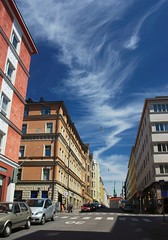 Finland is a land of lakes, mobile phones and M. A. Numminen. And don't forget the Kaurismäki brothers, film writers and directors, including Leningrad Cowboys go to America which is one of my all-time favourite movies (here's a musical number form the movie). Oh, and lately some rather entertaining political scandals, including one involving a foreign minister, a stripper and - appropriately - several hundred mobile phone text messages. The capital, Helsinki, is a small, charming city that has retained the somewhat sleepy feeling of a large town. Most of the center was built at around the same time, in the mid-1800's, and so the city has a more consistent aesthetic than many other european cities (to say nothing of a place like Osaka).
Finland is a land of lakes, mobile phones and M. A. Numminen. And don't forget the Kaurismäki brothers, film writers and directors, including Leningrad Cowboys go to America which is one of my all-time favourite movies (here's a musical number form the movie). Oh, and lately some rather entertaining political scandals, including one involving a foreign minister, a stripper and - appropriately - several hundred mobile phone text messages. The capital, Helsinki, is a small, charming city that has retained the somewhat sleepy feeling of a large town. Most of the center was built at around the same time, in the mid-1800's, and so the city has a more consistent aesthetic than many other european cities (to say nothing of a place like Osaka).Finnair, the Finnish flag carrier, flies direct routes between Finland and several Asian destinations, including Osaka. It's surprisingly convenient; Helsinki is the easternmost hub in Europe and right on the typical route between east Asia and Europe, so the flying time is short at only nine hours or so. If you're going anywhere in northern Europe you save a lot of time and pain compared to Frankfurt, or (horror!) Heathrow. We stayed in Helsinki for three nights to see the town and to meet up with a couple of friends. Ritsuko and I both like the movie Kamome Shokudo, set in Helsinki, giving us an additional reason to visit.
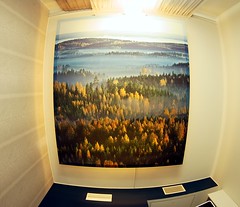
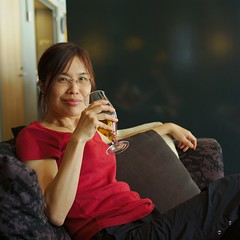
The hotel, Helka, was pleasant, with a small but fresh room in a modern Scandinavian style. The hotel restaurant was good (we ate there the first night), and breakfast was plentiful. The hotel bar and cafe is unusally good too, with plush chairs and sofas, coffee and beer at reasonable prices and freely available Wifi. Good place to stay.
Much of the time we spent walking around town. It is a fairly compact city, and you can easily get around by foot. If you do get tired, or you want to get around a little faster, Helsinki is farsighted enough to have kept their tram system intact. We did do some shopping - mostly some Scandinavian-style kitchen ware - but the Euro (and the Swedish crown) is very expensive so we didn't buy a lot. Some things (Arabica porcelain for instance) is actually cheaper in Osaka than in Finland.

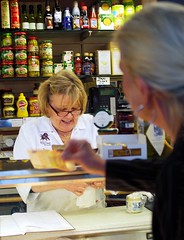
The harbour is an integral part of the city, and there's outdoor and indoor markets right on the pier. The outdoor market is a victim of its own fame; it's sadly rather touristy nowadays with most stalls hawking trashy souvernirs and t-shirts, while the fruit and fish stalls have been pushed to the edges or disappeared completely. The indoor market is more upscale and still feels reasonably interesting.
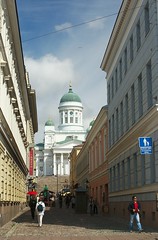
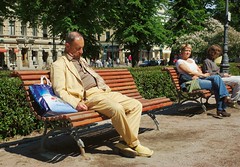
The cathedral is right in the center, up on a hill north of the harbour. This is as far as we got, though. A lot of the architecture really is mirroring St. Petersburg in Russia, east of here, which in turn was adapting central European building styles when it was founded.
Like everywhere in Scandinavia, any sun in early summer is a signal for everybody to spend as much time as humanly possible basking in its light. Sun worship was the original religion in this part of the world, and sometimes I wonder if that just never really went away, culturally.
The full set of Helsinki images is collected here.
Hvitträsk and Borgå
We spent Sunday outside Helsinki - the small town feel is reflected in the lack of open places on a Sunday - in Hvitträsk and then in Borgå, with a couple of friends as guides. Hvitträsk is an early 20th century building complex created by three of the most reknowned Finnish architects of the time, to use as their studio and summer home. After some internal unpleasantness (wife-swapping included) they abandoned the idea of a common place; after a series of ownership changes it was eventually bought by the state and turned into a public museum. The design is very nationalistic (this was around 1900 after all) and framkly rather heavier on the symbolism that I really like, but it's a very cool place nevertheless. The people designing it were consummate professionals and it shows (all images hare collected here.).

Hvitträsk main building. All that thatched wood is a little overdone, but a cool building nevertheless.
Borgå/Porvoo is a small town east of Helsinki with a fairly large partly medieval Old Town. It's a really pleasant place to walk around for half a day or so when the weather is good. The streets are cobblestoned and the buildings are wooden, in a style distinct from the wooden houses of Sweden and Norway, influenced as it is by east-European and Russian building styles. Photoset here.
Next up (well, eventually), Stockholm.
Tuesday, July 8, 2008
Yashica Camera
As I've mentioned, I got a 6x6 format (meaning the negative is a square 6x6cm) Yashica Twin-Lens Reflex film camera about a month ago.
Digital cameras are killing off the 35mm film format (and it already killed Polaroid film), but it has been a boon for medium-format film photography. Digital cameras, cheap scanners and the proliferation of information on the net means it is easier than ever to work with medium-format film. The continuing popularity of Holga, Diana and other toy medium-format film cameras is of course helping as well. According to photography store people in both Osaka and Stockholm (yes, two of them, total), both new and used medium format equipment has seen increasing sales for the past few years while 35mm is tanking. If you stay away from the big Brand names (Rolleiflex, Hasselblad), you can still find inexpensive and very capable used equipment.
My experience with the Yashica so far - after one roll of film - has been very positive. The camera is entirely manual of course, but easy to use; loading and unloading film, for instance, was no problem (just search the net for lots of instructions and tips). There's a light meter built in, but I've ignored it in favour of my digital camera. I use it as a light meter and "polaroid camera" for test shots. Once I'm happy with what the digital camera is showing me I can switch to the Yashica for the real shot. With only 12 pictures per roll you tend to take your time and really think things through before taking a picture. I'm certainly getting more images I'm happy with than I do with a digital camera.

They look a little silly, but lowrider bicycles are apparently fairly popular among a segment of young people here. This one is outside Sam and Dave's on sakaisuji street. Click on the image for a larger size, and you can find the full size on my Flickr photo stream.
Two things stand out with this camera: the viewfinder and the shutter. It has a glass focusing screen at the top - a big, beautiful focusing screen - that is just like having a digital camera live view, but without all its drawbacks (this really is live, after all, not recorded and shown on small screen). The viewfinder has a pop-up hood; in it is a small magnifying loupe you can flip up to check the focus precisely. The shutter is a leaf shutter (it's in the lens, not in front of the film), so it's almost silent, very fast, and produces no vibrations at all. And if you want to use flash (there's a flash socket on the camera) it will sync up to the maximum shutter speed.
There are drawbacks of course, but no serious ones. First, the viewfinder is flipped "left-to-right". As you look into the screen, it's the right side up, but your left side is on the right and vice versa. So when you want to see more of the left side of the image you need to turn right. Rather disorienting at first and takes a little while to get used to, but no big deal.
Using a separate camera to meter means you can't really react when the light changes quickly (the rain image below suffers from this); but then, this isn't a camera made for quick snapshots. The lens on the Yashica is quite good but has a few flaws. It's somewhat soft until you stop it down a fair amount, it has a tendency to flare (I need to get a hood, I think), and corners are quite fuzzy and smeared out (check the bottom corners in the bicycle image).
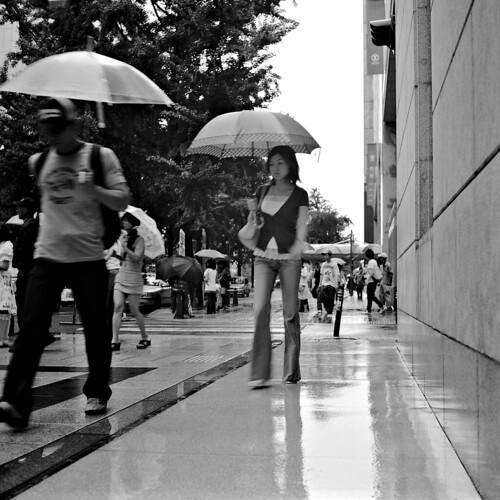
The rainy season - Tsuyu - is still going strong, creating fast-changing light as the weather whips back and forth between sort-of sunny and pouring rain. Film is better than digital at adapting to it, but there are limits of course.
With a camera bag over your shoulder and peering down a TLR hanging off your neck, you're not exactly Mr. Invisible. People know you're there and they know you have a big, old camera pointed at them. Nevertheless, it seems to be really good for street photography. While people easily notice you, they don't seem to be bothered by the camera the way they are with a DSLR and big lens, and the way you hold the camera means you naturally get a lower, more pleasant perspective on your subject.
Using film is not a problem either. It took me a month or so to use up my first roll, and that was with half the frames taken to test the camera. One roll is 250 yen and 500 yen to develop for a total cost of around 750 yen. Which, per month, is nothing I'd worry too much about. I could develop myself and save a bit, but really, why bother? I scan on an old flatbed scanner with a film holder (CanoScan D2400); we have a newer scanner at home but it has film holders only for 35mm, not medium format. And yes, you do want a scanner with a holder and overhead light; scanning film using the flatbed directly doesn't work.
The original scans are at 2400dpi; at that resolution the image is somewhat blurry - due to the scanner or the lens - so I downscaled them to half linear size. I could scale them larger than that, but I really don't need images that big anyway.
Digital cameras are killing off the 35mm film format (and it already killed Polaroid film), but it has been a boon for medium-format film photography. Digital cameras, cheap scanners and the proliferation of information on the net means it is easier than ever to work with medium-format film. The continuing popularity of Holga, Diana and other toy medium-format film cameras is of course helping as well. According to photography store people in both Osaka and Stockholm (yes, two of them, total), both new and used medium format equipment has seen increasing sales for the past few years while 35mm is tanking. If you stay away from the big Brand names (Rolleiflex, Hasselblad), you can still find inexpensive and very capable used equipment.
My experience with the Yashica so far - after one roll of film - has been very positive. The camera is entirely manual of course, but easy to use; loading and unloading film, for instance, was no problem (just search the net for lots of instructions and tips). There's a light meter built in, but I've ignored it in favour of my digital camera. I use it as a light meter and "polaroid camera" for test shots. Once I'm happy with what the digital camera is showing me I can switch to the Yashica for the real shot. With only 12 pictures per roll you tend to take your time and really think things through before taking a picture. I'm certainly getting more images I'm happy with than I do with a digital camera.

They look a little silly, but lowrider bicycles are apparently fairly popular among a segment of young people here. This one is outside Sam and Dave's on sakaisuji street. Click on the image for a larger size, and you can find the full size on my Flickr photo stream.
Two things stand out with this camera: the viewfinder and the shutter. It has a glass focusing screen at the top - a big, beautiful focusing screen - that is just like having a digital camera live view, but without all its drawbacks (this really is live, after all, not recorded and shown on small screen). The viewfinder has a pop-up hood; in it is a small magnifying loupe you can flip up to check the focus precisely. The shutter is a leaf shutter (it's in the lens, not in front of the film), so it's almost silent, very fast, and produces no vibrations at all. And if you want to use flash (there's a flash socket on the camera) it will sync up to the maximum shutter speed.
There are drawbacks of course, but no serious ones. First, the viewfinder is flipped "left-to-right". As you look into the screen, it's the right side up, but your left side is on the right and vice versa. So when you want to see more of the left side of the image you need to turn right. Rather disorienting at first and takes a little while to get used to, but no big deal.
Using a separate camera to meter means you can't really react when the light changes quickly (the rain image below suffers from this); but then, this isn't a camera made for quick snapshots. The lens on the Yashica is quite good but has a few flaws. It's somewhat soft until you stop it down a fair amount, it has a tendency to flare (I need to get a hood, I think), and corners are quite fuzzy and smeared out (check the bottom corners in the bicycle image).

The rainy season - Tsuyu - is still going strong, creating fast-changing light as the weather whips back and forth between sort-of sunny and pouring rain. Film is better than digital at adapting to it, but there are limits of course.
With a camera bag over your shoulder and peering down a TLR hanging off your neck, you're not exactly Mr. Invisible. People know you're there and they know you have a big, old camera pointed at them. Nevertheless, it seems to be really good for street photography. While people easily notice you, they don't seem to be bothered by the camera the way they are with a DSLR and big lens, and the way you hold the camera means you naturally get a lower, more pleasant perspective on your subject.
Using film is not a problem either. It took me a month or so to use up my first roll, and that was with half the frames taken to test the camera. One roll is 250 yen and 500 yen to develop for a total cost of around 750 yen. Which, per month, is nothing I'd worry too much about. I could develop myself and save a bit, but really, why bother? I scan on an old flatbed scanner with a film holder (CanoScan D2400); we have a newer scanner at home but it has film holders only for 35mm, not medium format. And yes, you do want a scanner with a holder and overhead light; scanning film using the flatbed directly doesn't work.
The original scans are at 2400dpi; at that resolution the image is somewhat blurry - due to the scanner or the lens - so I downscaled them to half linear size. I could scale them larger than that, but I really don't need images that big anyway.
Wednesday, July 2, 2008
This just in: Researchers also Stupid
In further proof that a) scientists are no smarter than anyone else outside their own field; and b) nobody really understands all the research funding rules any longer, Tokyo university researchers in engineering and medicine have been caught falsifying their accounting in order to keep unused research funds to use the next year. The sad thing is, the funding rules would have allowed them to keep the unused funds without resorting to false accounting had anyone bothered to check....
Tuesday, July 1, 2008
Fertility in the New York Times
A Sunday Times article asks the question of why there are so few babies born in parts of Europe. This is of course the same issue that Japan, Korea and some other countries are grappling with as well, and one that I've tried to cover before. The piece is rather verbose (yes, yes, I know - "pot, meet kettle. I'm sure you'll be god friends!") and light on detailed statistics, but it's a good read.
The piece describes how fertility has plummeted the world over, but fallen far below replacement in in southern and eastern Europe (the focus of the article) as well as in some parts of Asia, notably Japan and Korea. The reason is not the loss of religion or traditional values as some would argue; indeed, low-fertility southern and eastern Europe is a lot more conservative, family oriented and religious than the European north (which has a much healthier fertility rate).
And that is the key. In economically backwards, conservative, agrarian societies the fertility rate is high. A conservative, rigid lifestyle is well adapted to the economic situation - is perhaps necessary for social cohesion to be maintained.
In economically advanced, liberal societies with equal opportunities and help to combine children and an uncertain working life the fertility rate is, again, fairly high. The Scandinavian welfare state model provides assistance to parents with accessible daycare, paid parental leave, free schooling and so on. The US free-market model give parents enough workplace and societal flexibility to easily change occupation and working hours and allow people to leave and reenter the workforce without career stigma - the normally conservative USA has a notably liberal view of family life with regards to career and workplace issues, belying the idea that US moral conservatism is the reason for the fertility rate.
But the southern European countries along with Japan and Korea only modernised halfway. They are economically liberal, advanced societies that demand a great deal of flexibility and career committment from its citizens. But they still expect family life to conform to agrarian family values that are incompatible with their own societies; values that prevent them from providing the same support and flexibility to their citizens that the above societies do. They refuse to change their family and lifestyle values, and they can't renounce modernism and go back to a pre-industrial agrarian life. Stuck in the middle, prospective parents end up not having the children they wished they could have.
The greatest risk is being pointed to by Germany, as the article shows. There, being childless is increasingly seen not just as another lifestyle choice; it is gradually coming to be a desirable one. In most societies with a low fertility rate people want ot have more children than they do. But if people have fewer children than they want for long enough, that lower level will increasingly become the social norm. When people look around and see most of their peers and their parents generation with only one or no children, that becomes normal. If the societal tension between conservative family values and modernism persists for long enough - a couple of generations or more - then people may simply no longer want to have enough children even if they can.
The piece describes how fertility has plummeted the world over, but fallen far below replacement in in southern and eastern Europe (the focus of the article) as well as in some parts of Asia, notably Japan and Korea. The reason is not the loss of religion or traditional values as some would argue; indeed, low-fertility southern and eastern Europe is a lot more conservative, family oriented and religious than the European north (which has a much healthier fertility rate).
And that is the key. In economically backwards, conservative, agrarian societies the fertility rate is high. A conservative, rigid lifestyle is well adapted to the economic situation - is perhaps necessary for social cohesion to be maintained.
In economically advanced, liberal societies with equal opportunities and help to combine children and an uncertain working life the fertility rate is, again, fairly high. The Scandinavian welfare state model provides assistance to parents with accessible daycare, paid parental leave, free schooling and so on. The US free-market model give parents enough workplace and societal flexibility to easily change occupation and working hours and allow people to leave and reenter the workforce without career stigma - the normally conservative USA has a notably liberal view of family life with regards to career and workplace issues, belying the idea that US moral conservatism is the reason for the fertility rate.
But the southern European countries along with Japan and Korea only modernised halfway. They are economically liberal, advanced societies that demand a great deal of flexibility and career committment from its citizens. But they still expect family life to conform to agrarian family values that are incompatible with their own societies; values that prevent them from providing the same support and flexibility to their citizens that the above societies do. They refuse to change their family and lifestyle values, and they can't renounce modernism and go back to a pre-industrial agrarian life. Stuck in the middle, prospective parents end up not having the children they wished they could have.
The greatest risk is being pointed to by Germany, as the article shows. There, being childless is increasingly seen not just as another lifestyle choice; it is gradually coming to be a desirable one. In most societies with a low fertility rate people want ot have more children than they do. But if people have fewer children than they want for long enough, that lower level will increasingly become the social norm. When people look around and see most of their peers and their parents generation with only one or no children, that becomes normal. If the societal tension between conservative family values and modernism persists for long enough - a couple of generations or more - then people may simply no longer want to have enough children even if they can.
Subscribe to:
Posts (Atom)

